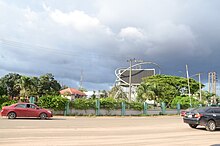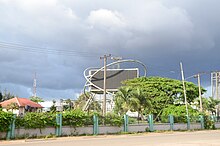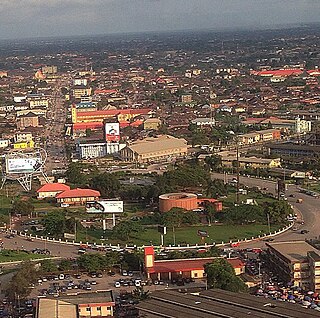
Benin City is the capital and largest city of Edo State, southern Nigeria. In central Kings square, the Benin city National Museum traces the Benin empire and has displays of terracotta sculpture. The Oba's palace is known for bronze plaques that once decorated with the walls, depicting historical events and Life at court. It is the fourth-largest city in Nigeria according to the 2006 census, after Lagos, Kano, and Ibadan. It is situated approximately 40 kilometres (25 mi) north of the Benin River and 320 kilometres (200 mi) by road east of Lagos. Benin City is the centre of Nigeria's rubber industry, and oil production is also a significant industry.
The Benin Expedition of 1897 was a punitive expedition by a British force of 1,200 men under Sir Harry Rawson in response to the ambush of a previous British embassy under Acting Consul General James Phillips, of the Niger Coast Protectorate. Rawson's troops captured and sacked Benin City, bringing to an end the Kingdom of Benin, which was eventually absorbed into colonial Nigeria.

The Oba of Benin is the traditional ruler and the custodian of the culture of the Edo people and all Edoid people. The then Kingdom of Benin has continued to be mostly populated by the Edo.

Ifẹ̀ is an ancient Yoruba city in south-western Nigeria, recent in-depth archeologically estimates suggest Ife's founding to be between the 10th century BC and 6th century BC and is widely agreed upon by historians to be the oldest amongst the classical and post-classical Yoruba city-states. The city is located in present-day Osun State. Ifẹ̀ is about 218 kilometers northeast of Lagos with a population of over 500,000 people, which is the highest in Osun State according to population census of 2006.
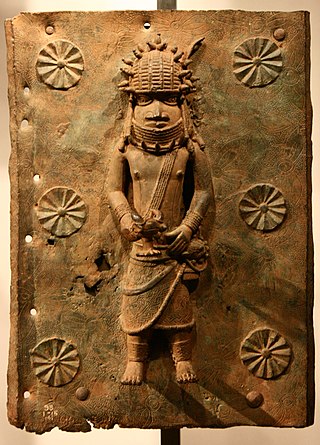
The Benin Bronzes are a group of several thousand metal plaques and sculptures that decorated the royal palace of the Kingdom of Benin, in what is now Edo State, Nigeria. Collectively, the objects form the best examples of Benin art and were created from the thirteenth century by artists of the Edo people. The plaques, which in the Edo language are called Ama, depict scenes or represent themes in the history of the kingdom. Apart from the plaques, other sculptures in brass or bronze include portrait heads, jewelry, and smaller pieces.
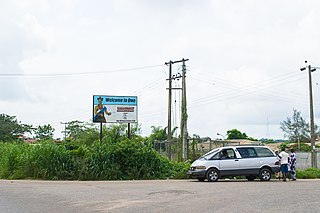
Owo is a local government area in Ondo state, Nigeria. Between 1400 and 1600 CE, it was the capital of a Yoruba city-state. The local government area has a population of 222,262 based on 2006 population census.

Edo, officially known as Edo State, is a state located in the South-South geopolitical zone of the federal republic of Nigeria. As of 2006 National population census, the state was ranked as the 24th populated state (3,233,366) in Nigeria. The state population figures is expected to be about 4,777,000 in 2022. Edo State is the 22nd largest State by landmass in Nigeria. The state's capital and largest city, Benin City, is the fourth largest city in Nigeria, and the centre of the country's rubber industry. Created in 1991 from the former Bendel State, it is also known as the heart beat of the nation. Edo State borders Kogi State to the northeast, Anambra State to the east, Delta State to the southeast and southsouth and Ondo State to the west.

Lagos is the largest city of the West-African country of Nigeria, and its former capital; it is the third largest city in Africa in terms of population with about 15.3 million people. It is also the 4th largest economy in Africa.
Sapele is a primary town and one of the Local Government Areas of Delta State, Nigeria.

Oba Esigie was the son of Oba Ozolua, who reigned in the late 15th century, and his second wife, Queen Idia. Oba Esigie ruled the ancient Benin Kingdom, now Benin City, Edo State, Nigeria. Works of art commissioned by Esigie are held in prominent museums including the Metropolitan Museum of Art and the British Museum.
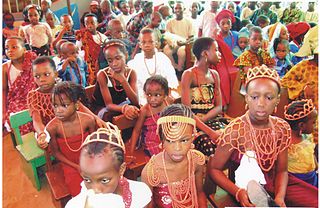
The Edopeople, sometimes referred to as the Bendel people, are an Edo-speaking ethnic group. The oredo who predominantly reside in 7 southern local government areas of the State of Edo, Nigeria are known as Benin. They are speakers of the edo language and are the descendants of the founders of the Benin Kingdom Ogiso Igodo. They are closely related to other southern Nigerian tribes, such as the Esan, the Etsakọ, the Isoko, and the Urhobo.

Uvwie (/hu-we-ɛ/), is a principal Urban Local Government Area in Delta State. It lies along the Warri River and it is one of the twenty-four Urhobo Kingdoms. The entirety of the LGA is conurbated with the city of Warri, making it a greater part of Warri metropolitan area
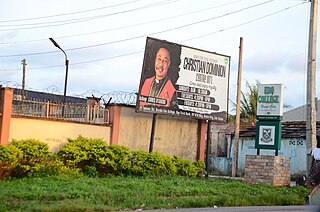
Edo College is a secondary grammar school in Benin City, Nigeria, the oldest in the Mid-Western Region. It was established in February, 1937 and started as the Benin Middle School with forms, I, II and III. In April 1937, the school, with a total student enrollment of 76 pupils, moved from its temporary site at the old Government School, Benin City to a permanent site, the present Idia College premises. In 1973, the school further moved from Idia College premises to its present site along Murtala Mohammed Way, Benin City. Edo state in the federal Republic of Nigeria.
Igueben is a local government area of Edo State, Nigeria. Its headquarters are located in the town of Igueben, which has an area of 380 km2 (150 sq mi) and a population of 69,639 according to the 2006 census. The postal code is 310.

Oredo is a Local Government Area of Edo State, Nigeria. Its headquarter is in Benin City. Its capital city is Benin City which also is the capital city of Edo State, Nigeria. Benin City is also the capital city of the Benin Empire. The Oba of Benin, Omo N'Oba Ewuare II's palace is located here. There are four major markets in Oredo Local Government Area; Oba market, New Benin market, New market and Ekiosa market.
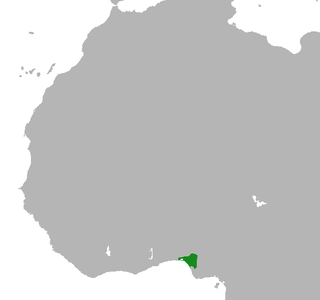
The Kingdom of Benin, also known as the Edo Kingdom or the Benin Empire, was a kingdom within what is now southern Nigeria. It has no historical relation to the modern republic of Benin, which was known as Dahomey from the 17th century until 1975. The Kingdom of Benin's capital was Edo, now known as Benin City in Edo State, Nigeria. The Benin Kingdom was "one of the oldest and most developed states in the coastal hinterland of West Africa". It grew out of the previous Edo Kingdom of Igodomigodo around the 11th century AD, and lasted until it was annexed by the British Empire in 1897.

The Benin River is a river that flows through the south west of Nigeria.
Igun Street, also known as Igun-Eronmwon Quarters, is a street situated in Benin City, Edo State, Nigeria. This street is renowned for being the residence of the Guild of Benin Bronze and Brass Casters, known as the Igun-Eronmwon. It holds the designation of a UNESCO World Heritage Site. Notably, it stands as the second most frequented tourist attraction within Benin City. Tourists, art dealers, and collectors routinely visit Igun Street to observe the comprehensive process involved in crafting these objects.
The Oba Market also referred to as Eki-Oba is an open-air market situated at Ring Road in the center of Benin City, Edo State, Nigeria. Its roots date back to the 15th century, making it one of the most historically significant markets in the region.

The government of Edo State serves as the governing authority for Edo State, one of the 36 states within the Federal Republic of Nigeria. It comprises three branches of government: the executive branch led by the Governor of Edo State, the legislative branch represented by the Edo State House of Assembly, and the judicial branch, including the Judiciary of Edo State and the Courts of Edo State. The state government operates under the frameworks of the Constitution of Nigeria and the Constitution of Edo State, delineating the powers, duties, and functions of state organs and institutions. It also encourages direct participation from the electorate through mechanisms such as initiative, referendum, and ratification.

